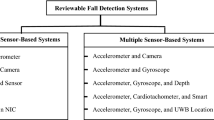Abstract
Falls are some of the most common sources of injury among the elderly. A fall is particularly critical when the elderly person is injured and cannot call for help. This problem is addressed by many fall-detection systems, but they often focus on isolated falls under restricted conditions, neglecting complex, real-life situations. In this paper a combination of body-worn inertial and location sensors for fall detection is studied. A novel context-based method that exploits the information from both types of sensors is designed. The evaluation is performed on a real-life scenario, including fast falls, slow falls and fall-like situations that are difficult to distinguish from falls. All the possible combinations of six inertial and four location sensors are tested. The results show that: (i) context-based reasoning significantly improves the performance; (ii) a combination of two types of sensors in a single physical sensor enclosure seems to be the best practical solution.
Access this chapter
Tax calculation will be finalised at checkout
Purchases are for personal use only
Preview
Unable to display preview. Download preview PDF.
Similar content being viewed by others
References
Breiman, L.: Random forests. Machine Learning 45, 5–32 (2001)
Dey, A., Salber, D., Abowd, G., Futakawa, M.: The conference assistant: Combining context-awareness with wearable computing. In: International Symposium on Wearable Computers, San Francisco, USA (1999)
Friedman, S.M., Munoz, B., West, S.K., Rubin, G.S., Fried, L.P.: Falls and Fear of Falling: Which Comes First? A Longitudinal Prediction Model Suggests Strategies for Primary and Secondary Prevention. Journal of the American Geriatrics Society, 1329–1335 (2002)
Gjoreski, H., Gams, M., Chorbev, I.: 3-axial accelerometers activity recognition. In: ICT Innovations, pp. 51–58 (2010)
Gjoreski, H., Luštrek, M., Gams, M.: Accelerometer Placement for Posture Recognition and Fall Detection. In: The 7th International Conference on Intelligent Environments (2011)
Gillespie, L.D., Robertson, M.C., Gillespie, W.J., Lamb, S.E., Gates, S., Cumming, R.G., Rowe, B.H.: Interventions for preventing falls in older people living in the community (Review). The Cochrane Library 4 (2009)
Gimon, D., Gjoreski, H., Kaluža, B., Gams, M.: Using accelerometers to improve position-based activity recognition. In: 13th International Multi-Conference Information Society, pp. 15–18 (2010)
Jantaraprim, P., Phukpattaranont, P., Limsakul, C., Wongkittisuksa, B.: Evaluation of fall detection for the elderly on a variety of subject groups. In: The 3rd International Convention on Rehabilitation Engineering & Assistive Technology (2009)
Kaluza, B., Dovgan, E.: Glajenje trajektorij gibanja cloveskega telesa zajetih z radijsko tehnologijo. In: Information Society, Ljubljana, Slovenia (2009)
Khawandi, S., Daya, B., Chauvet, P.: Automated monitoring system for fall detection in the elderly. International Journal of Image Processing (IJIP) 4(5) (2010)
Li, Q., Stankovic, J., Hanson, M., Barth, A.T., Lach, J., Zhou, G.: Accurate, Fast Fall Detection Using Gyroscopes and Accelerometer-Derived Posture Information. In: Sixth International Workshop on Wearable and Implantable Body Sensor Networks, pp. 138–143 (2009)
Li, Q., Stankovic, J.: Grammar-based, posture- and context-cognitive detection for falls with different activity levels. In: WH 2011: 2nd Conference on Wireless Health (2011)
Lin, H.-T., Hsieh, Y.-J., Chen, M.C., Chang, W.: ActionView: a movement-analysis ambulatory monitor in elderly homecare systems. In: IEEE International Symposium on Circuits and Systems, pp. 3098–3101 (2009)
Luštrek, M., Gjoreski, H., Kozina, S., Cvetković, B., Mirchevska, V., Gams, M.: Detecting Falls with Location Sensors and Accelerometers. In: Twenty-Third IAAI Conference (2011)
Machajdik, J., Zambanini, S., Kampel, M.: Fusion of Data from Multiple Cameras for Fall Detection. In: Workshop on Behaviour Monitoring and Interpretation, BMI 2010, pp. 1–7 (2010)
Rubenstein, L.Z., Josephson, K.R.: The epidemiology of falls and syncope. Clinics in Geriatric Medicine 18(2), 141–158 (2002)
Shan, S., Yuan, T.A.: Wearable Pre-impact Fall Detector using Feature Selection and Support Vector Machine. Systems, 1686–1689 (2010)
Tinetti, M.E., Williams, C.S.: Falls, Injuries Due to Falls, and the Risk of Admission to a Nursing Home. The New England Journal of Medicine 337, 1279–1284 (1997)
Ubisense RTLS website, http://www.ubisense.net (accessed June 2012)
World Health Organization (WHO). Global brief for World Health Day 2012. Good health adds life to years, http://whqlibdoc.who.int/hq/2012/WHO_DCO_WHD_2012.2_eng.pdf (accessed June 2012)
Witten, I., Frank, E.: Data Mining: Practical machine learning tools and techniques, 2nd edn. Morgan Kaufmann (2005)
XSens sensors website, http://www.xsens.com (accessed June 2012)
Zinnen, A., Wojek, C., Schiele, B.: Multi Activity Recognition Based on Bodymodel-Derived Primitives. In: Choudhury, T., Quigley, A., Strang, T., Suginuma, K. (eds.) LoCA 2009. LNCS, vol. 5561, pp. 1–18. Springer, Heidelberg (2009)
Zhang, T., Wang, J., Xu, L., Liu, P.: Fall Detection by Wearable Sensor and One-Class SVM. Intelligent Computing in Signal Processing and Pattern Recognition 345, 858–863 (2006)
Author information
Authors and Affiliations
Editor information
Editors and Affiliations
Rights and permissions
Copyright information
© 2012 Springer-Verlag Berlin Heidelberg
About this paper
Cite this paper
Gjoreski, H., Luštrek, M., Gams, M. (2012). Context-Based Fall Detection Using Inertial and Location Sensors. In: Paternò, F., de Ruyter, B., Markopoulos, P., Santoro, C., van Loenen, E., Luyten, K. (eds) Ambient Intelligence. AmI 2012. Lecture Notes in Computer Science, vol 7683. Springer, Berlin, Heidelberg. https://doi.org/10.1007/978-3-642-34898-3_1
Download citation
DOI: https://doi.org/10.1007/978-3-642-34898-3_1
Publisher Name: Springer, Berlin, Heidelberg
Print ISBN: 978-3-642-34897-6
Online ISBN: 978-3-642-34898-3
eBook Packages: Computer ScienceComputer Science (R0)





